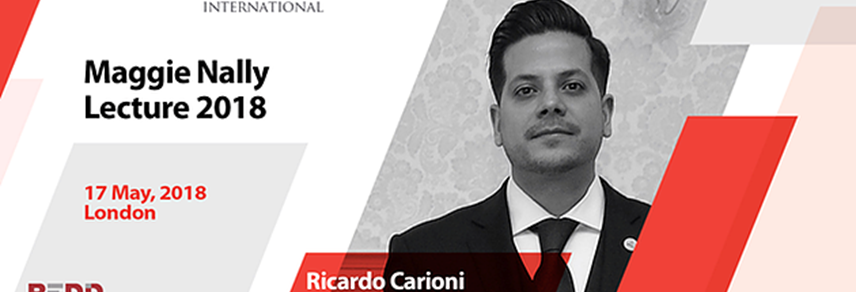
RICARDO CARIONI KEYNOTE SPEAKER AT MAGGIE NALLY MEMORIAL LECTURE 2018
The middle class in Latin America is larger than that of India and China combined. Benefitting from a heady combination of investment, industrial innovation and a rapidly growing young population, the region’s 19 countries are prime for change. This, says Ricardo Carioni, deputy head of mission at the Embassy of Nicaragua to the UK and Ireland, and keynote speaker at the Maggie Nally Memorial Lecture 2018, is what drives the region’s growing contribution to global PR and communications. Here, he speaks exclusively to Communicate magazine.
This year taking place at the Institute of Civil Engineers in Whitehall, London, the annual Maggie Nally Memorial Lecture celebrates the late Maggie Nally, first female CIPR president's, contribution to the PR landscape. Organised by the Chartered Institute of Public Relations (CIPR) International and concluded by current CIPR president Sarah Hall, the lecture series has since 2003 welcomed esteemed guests, often talking about their experience in global communications. This year was no different, with Ricardo Carioni discussing how his role as a diplomat and as director of the Latin American Trade and Investment Association (LATIA) provides a helicopter perspective on the changing PR landscape across Latin America.
For Carioni, much of the fascination and excitement offered by the region’s prospects lies in its sheer size and diversity. “There’s over 600 million people, and it’s such a variety of cultures and demographics,” says Carioni. “From 77 tribes untouched in the Amazon to industrialised and populous cities such as Sao Paulo or Mexico City - when you look at those in the framework of the middle class it’s growing more rapidly than any other. And if we look back at 2001-2011, approximately 70 million people left poverty. So this wave of growth and changes have created a landscape of opportunities across all the sectors.”
From a communications perspective, the opportunities offered by Latin America’s 19 countries is as diverse as its population. “From companies and corporation in the more traditional sectors historic to the key growth of markets in Latin America such as agriculture and food, to the diversity of populations and this very rapidly growing consumer base population - what’s great about Latin America is the potential to keep growing,” says Carioni. As brands continue to grow from or expand into the region, the potential for creative communications and new campaigns grows, which in turn will help brand growth and should continue to attract investment in the region.
But, warns Carioni, it is key not to view Latin America as a simply a homogenous entity. This is true for many regions of the world, where western practitioners are often prone to applying the same or similar characteristics to countries simply due to their geographical proximity. Segmentation is key, says Carioni, and is often a pitfall of brands hoping to make their mark on the Latin America economy. “One size does not fit all in Latin America, but to the naked eye it’s very easy to assume that it’s the same language, it’s easy to come with a mistaken frame of mind,” says Carioni, “But that couldn’t be further from the truth once you actually get on the ground.”
Carioni continues, “Working across Latin America presents an opportunity to really segment communications strategy. This then needs to be vocalised very carefully and curated, and then it’s a matter of how you deal with locals or people with a real knowledge of the region or community to start with the process of integrating and getting communities on board.”
“This is so key because in fairly recent history some of the biggest multinational projects and investments have fallen to nothing and haven’t grown or developed on many occasions for a lack of strategy, or communicating with communities. Ultimately the communities of indigenous people can say “No, this bridge it won’t be built,’ or 'No this mine won’t be functioning.” So these new commodities and new opportunities require a very refined level of strategy of communicating with the locals and then going back to the stakeholders of the organisations, from the members of the board to the investors to the press in general. For PR professionals in the regions, it’s about being able to present the best possible image of the situation and take it in a positive step.”
As well as his diplomatic roles, Carioni is also president of Latin American Group of Permanent Missions at the United Nations International Maritime Organisation (IMO) and represents Nicaragua at the International Coffee Organisation and International Sugar Organisation. While a lot of responsibility, Carioni explains how involvement in a variety of international organisations a unique global perspective often limited among public relations professionals - and allows him to contribute to the external perceptions of both Nicaragua, and Latin America more broadly.
“Communication is very key to us not only at a country level, but at a regional level - as a whole, it’s a region that is a lot of work in terms of presenting the realities of the region and the countries,” says Carioni. “There’s a lot of preconceptions and ideas on what the region has and what it means to work there, so myself and my colleagues do the best we can in the limited ability we have to try and communicate to the UK audience and European stakeholders what’s happening in Latin America.”
Ultimately, says Carioni, expansion into Latin America and its associated countries will only gather pace. As the economy continues to diversify and grow, and new forms of capitalism emerge, how communicators can tap into and adapt to the demands of dormant markets will determine their success.
Communicators must “Be sensitive to the culture and language, understand and put into practice the need to be sensitive towards the region’s diversity, and research the differences to a T,” he states. Only then will practitioners be able to translate experience into other regions. Above all, says Carioni, “It does give you an opportunity to think more globally.” New technologies and new strategies present fertile ground for both individual development, and development of the overall industry. It will be interesting to see where the region takes PR and communications next. A
For more from Communicate magazine, follow us on Twitter @Communicatemag


